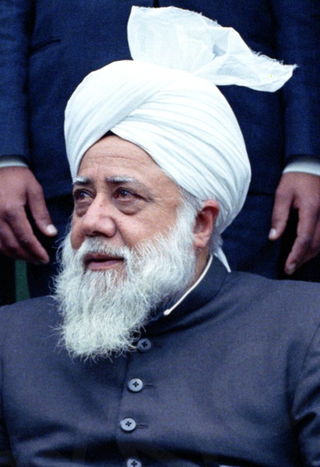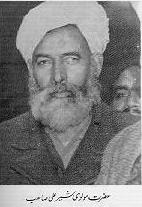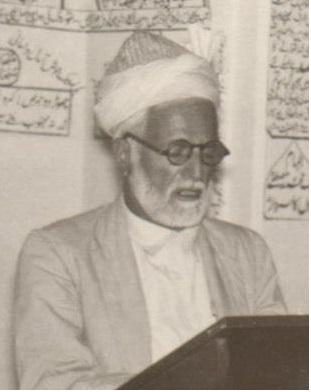Rabwah, officially known as Chenab Nagar, is a city in Chiniot, Punjab, Pakistan on the bank of Chenab River. It was the headquarters of the Ahmadiyya Muslim Community from September 20, 1948 when the community relocated from Qadian, India to the newly created state of Pakistan, where the community leased the area of present-day Rabwah from the government to establish its home. This continued until 1984 and the establishment of Ordinance XX. In 1984, the headquarters were moved to the United Kingdom with Mirza Tahir Ahmed, first to London and then in 2019 to the Islamabad compound in Tilford, Surrey.

The Ahmadiyya Caliphate is a non-political caliphate established on May 27, 1908, following the death of Mirza Ghulam Ahmad, the founder of the Ahmadiyya Muslim Community, who claimed to be a Prophet, a Messenger, the promised Messiah and Mahdi, the expected redeemer awaited by Muslims. It is believed by Ahmadis to be the re-establishment of the Rashidun Caliphate that commenced following the death of the Islamic prophet Muhammad. The caliphs are entitled Khalīfatul Masīh, sometimes simply referred to as Khalifa. The caliph is the elected spiritual and organizational leader of the worldwide Ahmadiyya Muslim Community and is the successor of Ghulam Ahmad. He is believed by the Community to be divinely ordained and is also referred to by its members as Amir al-Mu'minin and Imam Jama'at. The 5th and current Caliph of the Messiah of the Ahmadiyya Community is Mirza Masroor Ahmad.

Qadian is a city and a municipal council in Gurdaspur district, north-east of Amritsar, situated 18 kilometres (11 mi) north-east of Batala city in the state of Punjab, India. Qadian is the birthplace of Mirza Ghulam Ahmad, the founder of the Ahmadiyya movement within Islam. It remained the headquarters of the Ahmadiyya movement until the Partition of India in 1947.

Mirza Tahir Ahmad was the fourth caliph and the head of the worldwide Ahmadiyya Muslim Community. He was elected as the fourth successor of the founder of the community, Mirza Ghulam Ahmad. He was elected on 10 June 1982, the day after the death of his predecessor, Mirza Nasir Ahmad.

Mirza Nasir Ahmad was the third Caliph of the Ahmadiyya Muslim Community from Pakistan. He was elected as the third successor of Mirza Ghulam Ahmad on 8 November 1965, the day after the death of his predecessor and father, Mirza Basheer-ud-Din Mahmood Ahmad.

Mirza Basheer-ud-Din Mahmood Ahmad was the second caliph, leader of the worldwide Ahmadiyya Muslim Community and the eldest son of Mirza Ghulam Ahmad from his second wife, Nusrat Jahan Begum. He was elected as the second successor of Mirza Ghulam Ahmad on 14 March 1914 at the age of 25, the day after the death of his predecessor Hakim Nur-ud-Din.

Hakeem Noor-ud-Din was a close companion of Mirza Ghulam Ahmad, the founder of the Ahmadiyya Movement, and his first successor and first Ahmadiyya caliph since 27 May 1908.

Mirza Masroor Ahmad is the current and fifth leader of the Ahmadiyya Muslim Community. His official title within the movement is Fifth Caliph of the Messiah. He was elected on 22 April 2003, three days after the death of his predecessor Mirza Tahir Ahmad.

Jalsa Salana is a formal, annual gathering of the Ahmadiyya Muslim Community. It was initiated in 1891 by Mirza Ghulam Ahmad, the founder of the community, in Qadian, India. Usually, the gathering spans three days, beginning with the flag hoisting ceremony following the Friday Sermon. Although the convention held in the UK is deemed to be the major and 'international Jalsa' attended by Ahmadis from across the world, Ahmadis in other countries hold their own national Jalsas, sometimes attended by the Khalifatul Masih.

Lajna Ima’illah is the women's auxiliary organization of the Ahmadiyya Muslim Community. It is for women above the age of 15. The organization was established in 1922 by Mirza Bashir-ud-Din Mahmud Ahmad, the second Caliph of the Community to give women a voice in the administrative affairs of the Community and a degree of independence. It is the largest of the auxiliary organizations within the Community.

Daily Al-Fazl is one of the oldest dailies in the Indian subcontinent, an organ run by the Ahmadiyya Muslim Community. It was initiated by Mirza Basheer-ud-Din Mahmood Ahmad on June 18, 1913. The initial monetary responsibilities were fulfilled through donations by members of the community. The newspaper has been publishing the sermons, sayings and announcements of Ahmadiyya Caliphates for nearly a century. In Pakistan, the Al-Fazl was subject to the Pakistani law enforcement which suspended the publication of the newspaper for several months in 1984, and since 2015 it is not being published in Pakistan and has also shifted to Islamabad, Tilford in Surrey, England.

Majlis Khuddam-ul-Ahmadiyya is one of five auxiliary organizations in the Ahmadiyya Muslim community. It is the young men's branch of the community, particularly for those between the ages of 15 and 40. In some English-speaking countries it is also known as the Ahmadiyya Muslim Youth Association (AMYA).
Bahishti Maqbara, located originally in Qadian, India, and then in Rabwah, Pakistan, is a religious cemetery established by the Ahmadiyya Community as a directive from the community's founder Mirza Ghulam Ahmad, made known in his booklet Al-Wasiyyat. Mirza Ghulam Ahmad established it in his will after he saw an angel showing him the place of his burial.

Jāmi’ah al-Ahmadīyyah is an International Islamic seminary and educational institute with campuses in Pakistan, United Kingdom, India, Ghana, Canada, Germany, Nigeria, Indonesia, Bangladesh, Malaysia, Tanzania, Sri Lanka, Sierra Leone, and Kenya. In addition, there are affiliated Mu'alameen centers in Pakistan and Madagascar. Founded in 1906 as a Section in Madrassa Talim ul Islam by Mirza Ghulam Ahmad of Qadian, the founder of the Ahmadiyya Muslim Community, it is the main centre of the Ahmadiyya Muslim Community for Islamic learning.
In the period spanning from late May to early September 1974, an altercation between students of Islami Jamiat-e-Talaba and youths of the Ahmadiyya Muslims Community at the Rabwah railway station. This incidents were marked by a series of events such as protests, violence, property damage, and governmental actions against the Ahmadiyya community across Pakistan. These events reportedly resulted in casualties among Ahmadi individuals and damage to Ahmadi mosques. Furthermore, in response to these events, the government took actions, including constitutional amendments, related to the status of Ahmadis.

Maulvi Sher Ali Ranjha was a prominent Ahmadi scholar and a companion of Mirza Ghulam Ahmad, who claimed to be the Promised Messiah and the awaited mahdi.

Chaudhry Fateh Muhammad Sial (1887–1960) was a companion of Mirza Ghulam Ahmad and the first Ahmadi missionary sent from India, under the leadership of Hakeem Noor-ud-Din, the first Khalifa of the Ahmadiyya movement. In 1913, Mirza Basheer-ud-Din Mahmood Ahmad asked for volunteers to serve as Ahmadi missionaries in England. Sial volunteered and travelled to England on June 22, 1913 and arrived the following month. There he served twice as a missionary. He earned an MA in Arabic from the Aligarh Muslim University.

Shams ud Din Khan (1900–1969) was a notable early Pashtun Ahmadi in the North West Frontier province of India. He remained its Provincial Ameer [Head] (1969). He was a close associate of Khalifatul Masih II and III.( Mirza Basheer-ud-Din Mahmood Ahmad and Mirza Nasir Ahmad) in his lifetime. He was a member of the Jama’at Khilafat Committee [Electoral College] and was one of the two proposers of the name of Mirza Nasir Ahmad at the time of his Election to the seat of Khilafat in November 1965. He remained a member of the Majlis Shura [Consultative Assembly] of the Ahmadiyya Muslim Community in Pakistan.
Nazarat Taleem(Directorate of Education), launched in 1919, is a directorate within the Sadr Anjuman Ahmadiyya, in Pakistan, responsible for the task of formalizing education within schools and colleges of the Ahmadiyya Muslim Community Pakistan.













